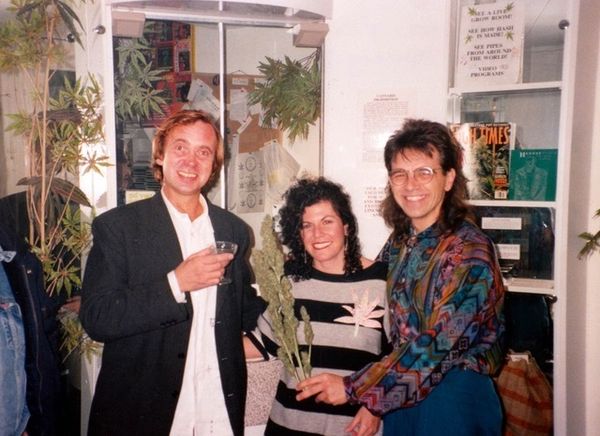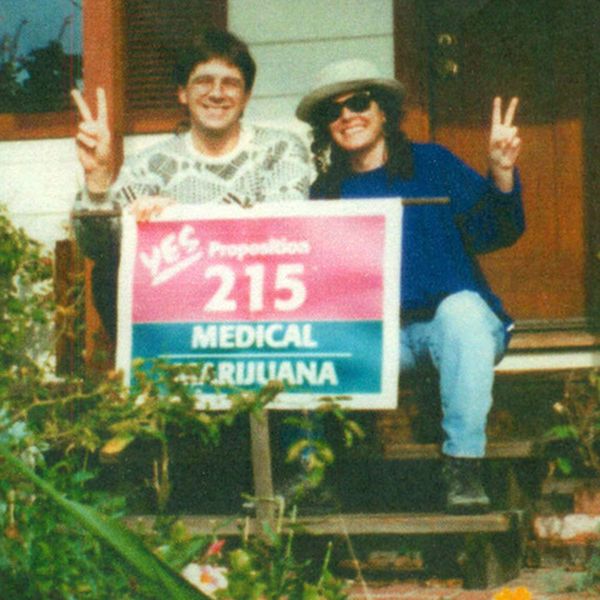Activists
Chris Conrad and Mikki Norris in 1996
What the Slow Arc of Pot Legalization Looks Like from the Activist Front Lines
“Social change takes much longer than we ever thought. In fact, political movements are usually multi-generational efforts,” writes Mikki Norris, iconic cannabis reform and social justice activist.
by Mikki Norris
All photos courtesy of the author
When my husband, Chris Conrad, and I became cannabis activists in 1988, it was the height of Reagan’s “Just Say No” and zero tolerance era. The Anti-Drug Abuse Act of 1986 enacted mandatory minimum sentences for drugs, so the arrest and incarceration rates were starting to amp up, and people who enjoyed pot were heading back into the cannabis closet.
Chris was at an election victory party for insurance reform the night George H. W. Bush won office. Smoking a celebratory joint in the parking lot with his political allies, Chris announced that it was time to do something about the marijuana laws. He felt it unfair that responsible pot smokers were, literally, being kept out in the cold. They stood in the November night, vulnerable to arrest, while their colleagues were indoors freely drinking alcohol. Feeling inspired by the injustice of the situation, he asked everyone to join him in a quick campaign for marijuana legalization.
“Are you crazy?” they retorted. “You will lose all credibility and destroy your reputation. Marijuana will never be legal. It can’t be done.”
Chris took that as a personal challenge and bet that he could make and implement a successful plan. Within weeks, he formulated and launched the Business Alliance for Commerce in Hemp (BACH) as a five-year strategy to legalize marijuana in North America. At the time, there were no hemp businesses except hemp birdseed and twine. BACH’s goal was to restore the perception of hemp for industrial use, allow medical marijuana, legalize personal adult-use and home grows, and regulate the commercial cannabis market.
A five-year plan seemed doable, with plenty of time. We developed educational materials to inform people about the many uses of hemp, its benefits to the economy, environment, civil and human rights, as well as health care. In 1989, we formed the Family Council on Drug Awareness, then the American Hemp Council, and held organizing meetings at our Los Angeles apartment. We developed a national network of hempsters interested in changing the laws. Pre-internet, Chris designed literature to be photocopied by activists — “The Many Uses of Hemp,” “Ten Things Every Parent Teenager and Teacher Should Know About Marijuana,” and “Marijuana and the Bible,” to name a few. He collaborated with Jack Herer to edit and design what became the best seller of the hemp movement, Herer’s The Emperor Wears No Clothes. We did hemp events at our local federal building and cross-country speaking and networking tours in the early 1990s to spread the word.
Obviously, once enough people knew how great and beneficial cannabis is, there would be no reason to keep it stigmatized and prohibited. The truth will set us free, right? With other volunteers, we wrote the comprehensive California Hemp Initiative using petition drives as good educational opportunities. People loved our messaging, but lacking money, we came nowhere close to landing on the ballot.
Hemp and cannabis reform was gaining ground, though. Judge Francis Young told the DEA to reschedule medical marijuana. The movement was rolling on many fronts.
So we went to Europe for a year in 1991 to experience other cultures and see what was happening in the cannabis community internationally. We lived in Spain, where Chris wrote his first book, Hemp: Lifeline to the Future. We came back to publish it but returned to Amsterdam six months later in 1993 to design and curate the Hash Marihuana and Hemp Museum with Ben and Alan Dronkers. We experienced a semblance of what cannabis freedom and tolerance looked like in The Netherlands. The Dutch model gave consumers pleasant environments at coffeeshops to buy and consume cannabis — without fear of arrest — and this was just what we wanted for the United States.

Virginia Resner, Mikki Norris, and Chris Conrad at the opening of “Human Rights 95” exhibit in San Francisco, 1995
See Full Article at: https://merryjane.com/culture/the-long-slow-arc-of-pot-legalization-mikki-norris-essay-2018






